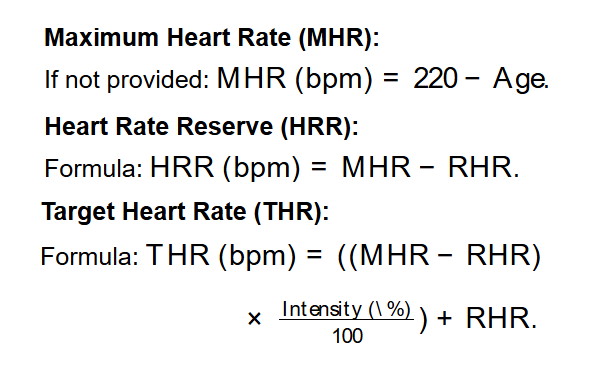1. What is a Karvonen Formula Calculator?
Definition: This calculator computes your Maximum Heart Rate (MHR), Target Heart Rate (THR), and Heart Rate Reserve (HRR) using the Karvonen formula. You can either input your MHR directly or have it calculated based on your age, along with your resting heart rate (RHR) and desired exercise intensity.
Purpose: It helps athletes and fitness enthusiasts target specific heart rate zones for effective training, such as fat-burning, cardio, or peak performance, ensuring workouts are safe and efficient.
2. How Does the Calculator Work?
The calculator takes resting heart rate (RHR), exercise intensity (in percentage), and either your age or maximum heart rate (MHR), and computes:
- Maximum Heart Rate (MHR):
- If not provided: \( \text{MHR (bpm)} = 220 - \text{Age} \).
- If provided: Uses the input value.
- Represents the highest heart rate you can achieve, in beats per minute (bpm).
- Heart Rate Reserve (HRR):
- Formula: \( \text{HRR (bpm)} = \text{MHR} - \text{RHR} \).
- Measures the range between your resting and maximum heart rates, in bpm.
- Target Heart Rate (THR):
- Formula: \( \text{THR (bpm)} = ((\text{MHR} - \text{RHR}) \times \frac{\text{Intensity (\%)}}{100}) + \text{RHR} \).
- Calculates the heart rate to aim for during exercise, based on intensity, in bpm.
Steps:
- Input your resting heart rate (RHR) in beats per minute (bpm).
- Select whether you know your maximum heart rate (MHR). If yes, input it; if no, input your age to calculate it.
- Input your desired exercise intensity (in percentage, 0–100%).
- Compute your MHR (if not provided), HRR, and THR, displayed in bpm.
3. Importance of Karvonen Formula Calculations
Using the Karvonen formula is useful for:
- Effective Training: Ensures you exercise at the right intensity for your goals, such as fat-burning or cardiovascular improvement.
- Safety: Prevents overexertion by tailoring heart rate targets to your fitness level, using your resting heart rate and heart rate reserve.
- Personalization: Accounts for individual differences in fitness by incorporating resting heart rate and allowing direct MHR input if known.
4. Using the Calculator
Examples:
- Example 1 (MHR Calculated): Age = 20 years, RHR = 70 bpm, Intensity = 60% (fat-burning zone), MHR not provided
MHR: \( 220 - 20 = 200 \, \text{bpm} \).
HRR: \( 200 - 70 = 130 \, \text{bpm} \).
THR: \( ((200 - 70) \times \frac{60}{100}) + 70 = 148 \, \text{bpm} \).
- Example 2 (MHR Provided): RHR = 65 bpm, Intensity = 80% (cardio zone), MHR = 195 bpm
HRR: \( 195 - 65 = 130 \, \text{bpm} \).
THR: \( ((195 - 65) \times \frac{80}{100}) + 65 = 169 \, \text{bpm} \).
5. Frequently Asked Questions (FAQ)
Q: What is the fat-burning zone?
A: The fat-burning zone is typically at 60% intensity using the Karvonen formula. At this level, your body primarily burns fat for energy. For example, a 20-year-old with an RHR of 70 bpm and a calculated MHR of 200 bpm has a fat-burning THR of 148 bpm.
Q: What is Heart Rate Reserve (HRR)?
A: Heart Rate Reserve (HRR) is the difference between your maximum heart rate (MHR) and resting heart rate (RHR). It represents the range your heart rate can increase during exercise and is used in the Karvonen formula to calculate your target heart rate.
Q: How do I know my maximum heart rate (MHR)?
A: If you don’t know your MHR, the calculator estimates it as 220 minus your age. Alternatively, you can determine it through a stress test or by monitoring your heart rate during maximal exercise, though this should be done safely and ideally under medical supervision.
 Home
Home
 Back
Back
